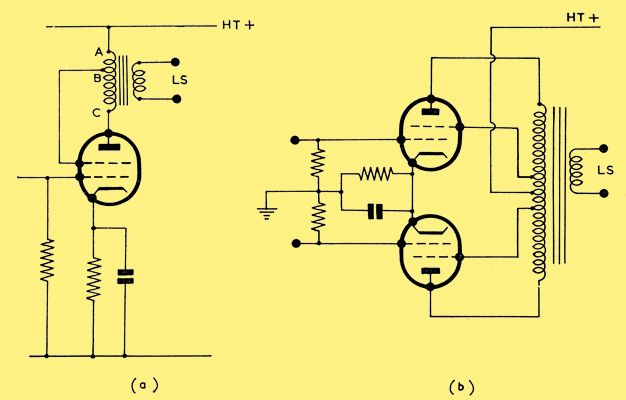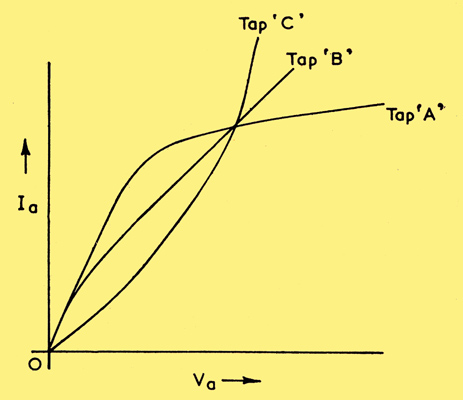|
Ultra Linear or Distributed Loading is used to reduce harmonic distortion in a pentode of beam tetrode audio amplifier push-pull output stage.

The ultra linear arrangement applied to both a single-ended and a push-pull stage.
The ultra-linear or distributed load method of operating a push-pull output stage in an audio amplifier has been known for some years now, and was first employed in a commercially produced amplifier just after the war. It consists of distributing the load impedance between the screen grid and anode of each output valve in order to achieve a reduction in the harmonic distortion which the output stage introduces. In its basic form the circuit appears as seen above.
The arrangement differs from that normally used only in that the screen grid is tapped into the primary of the output transformer; this makes a part of the load common to both the screen and anode circuits. If the tapping point is moved to C the valve behaves as a triode, whilst if it is at A the performance is that of a normal tetrode. Thus as the tapping point is moved progressively from C to A, the characteristic changes from triode to tetrode. The effect which this has on the anode-current/anode-voltage characteristic of the valve is shown below. This set of curves indicates the way in which the curve shape changes as the tapping point is adjusted.

Ia/Va characteristic showing the change in shape as the output transformer tap is changed.
It will be apparent from the circuit diagram that the arrangement is virtually a tetrode output stage operating with negative feedback applied to the screen grid. As the feedback is increased, so the permissible anode swing is decreased because of anode current cut-off on the negative half-cycle. This reduces the maximum output. The optimum tapping point on the output transformer will depend on the type of output valves employed, but it is usually in the region of 20 per cent from the top. This only reduces the available output power by about 10 per cent, but the distortion can be reduced by as much as 50 per cent in a push-pull stage.
The screen grid characteristic of the valve introduces a non-linear element into the feedback circuit, and this can result in an increase in even harmonic distortion in a single-ended output stage. However, when using push-pull the even order harmonics tend to cancel out in the load circuit. It is under these conditions that the ultra-linear circuit offers its main advantages - a reduction in distortion at the expense of only a small decrease in power efficiency, coupled with an appreciable reduction in output resistance resulting from the negative feedback.
It is generally preferable to apply feedback to an audio amplifier in a series of separate loops, each embracing a minimum number of stages. By so doing, the phase shift in each loop is kept small and the stability and response of the amplifier preserved. The ultra-linear circuit covers only the output stage, and leaves the designer free to choose the remainder of the circuit constants without the added difficulties associated with the more conventional wide loop feedback. When considering the bias circuit of an ultra-linear output stage, it is important when a common cathode resistor is used to shunt it with a large value capacitor (at least 100μF).
Finally, a note about the output transformer. It is reasonable to state that any amplifier is only as good as the output transformer, it being false economy to purchase a cheap component. The various windings and sections of windings on a transformer are coupled by a complex system of leakage reactances which may produce a large phase shift at the higher frequencies. This can, in turn, result in peaks forming in the frequency response, and may, in severe cases, result in instability. Troubles of this nature can only be avoided by using tightly coupled windings and by keeping the shunt capacitances to a minimum; in other words, by using a well-designed and well-made transformer.
See also Tetrodes with screen feedback & Distributed loading
|